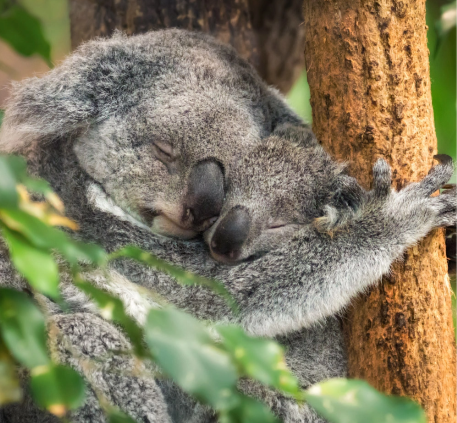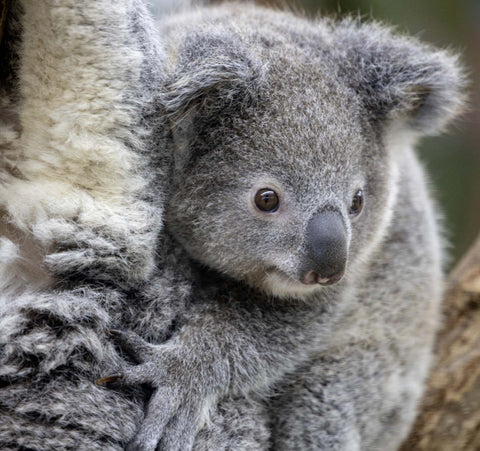Koala Research & Education
EDUCATION & PARTNERSHIP
Research Insights and Collaboration
- Research Overview
- Koala Conference
- Training & Manuals
Expanding Knowledge
Despite its notoriety as an iconic Australian species, there is still a surprising amount we do not know about the koala. More research is required to better understand how we can help conserve wild koalas. We are currently collaborating with universities around the world to learn more about koalas as a species.
Koala Conservation Australia provides valuable information and resources to assist with research and believes in using an evidence-based approach to clinical treatment and conservation and in expanding our knowledge about koalas through research. Much of this research has been conducted in collaboration with universities. For researchers who wish to discuss a collaboration, please contact Koala Conservation Australia directly to discuss your project with the clinical team.

Fostering Collaboration
The Koala Hospital hosts a three-day National Koala Conference, with the last one in 2022, showcasing our commitment to sharing knowledge and fostering collaboration in koala research. Additionally, the Koala Hospital serves as a pivotal training facility, educating wildlife carers, veterinarians, researchers, and zookeepers on best practices in koala care and conservation. Authored by our Clinical Director, the Koala Hospital’s Rehabilitation Manual, now in its sixth edition, is provided at cost throughout Australia and to zoos in Europe, further underlining our role in spreading valuable knowledge and expertise in koala conservation.

Educational Impact
The Koala Hospital is a pivotal training facility that educates wildlife carers, veterinarians, researchers, and zookeepers on best practices in koala care and conservation. You can find more details on our Professional Development options here.
The Koala Hospital’s Rehabilitation Manual, now in its sixth edition, is provided at cost throughout Australia and to zoos in Europe, further underlining our role in spreading valuable knowledge and expertise in koala conservation. This manual can be purchased from our online shop.

DISCOVER THE KOALA WORLD
At the Koala Hospital and Koala Conservation Wild Breeding Guulabaa
The public has the opportunity to connect with koalas and deepen their understanding of survival threats
through various interactive experiences.
Exhibit Exploration
Koala Observation
Guided Insights
Educational Reading
Koalaseum Visit
Clinical Viewing
EDUCATIONAL OUTREACH PROGRAMS
Schools and Community
The Koala Conservation Australia team can do presentations for school and community groups on request. Koala Conservation Australia helps educate people on measures they can take to help reduce threats to koalas. For example, in the past the Koala Hospital, in association with council, carried out a pilot program helping dog owners to train their dogs to avoid koalas. Koala Conservation Australia holds an annual koala food tree giveaway in conjunction with Forestry Corporation NSW to encourage people to increase suitable koala habitat and create linkages between these habitat patches.
Community Engagement
Connects groups with conservation through interactive presentations
Habitat Awareness
Educates on enhancing koala habitats and linkages
Conservation Action
Encourages active participation in koala protection efforts
Support our vital research to safeguard koalas. Your donation makes a crucial difference.

Curious about Koalas?
FAQ’s
Are koalas endangered?
Koalas are found from north Queensland down into NSW, ACT, Victoria and South Australia. There are also a number of translocated populations on islands such as Kangaroo, St Bees, Raymond, Snake and Phillip Island. In 2022, the koala was officially listed as an endangered species. Severe droughts that occurred prior to 2019, followed by the 2019/2020 bushfires have had a major impact on the already declining koala populations. Until rigorous scientific survey work of how many koalas are left is completed, how many remain is still really unknown.
At what age do joeys emerge from their mother’s pouch?
Most joeys emerge from the pouch at around 5-6 months, they usually weigh anywhere from 450 grams upward (depending on where they come from). These young emergent joeys sit hugging their mothers bellies or clinging to her back. Eventually they become fully back young, until they are too heavy to be carried. The joeys will continue to feed from the mother and are weaned by 12 months of age
At what age do koalas become sexually active?
The female reaches sexual maturity at the end of her second year or later and physical maturity at the end of her fourth year. Males – about 3 years sexual maturity and reach physical maturity at 4 years. It is not unusual for this to occur at a younger age as well.
Do koalas get drunk on eucalypt leaves?
The eucalypt leaf is very low in viable nutrients and koalas have a slightly lower body temperature and consequently a lower metabolic rate than most other mammals, to reduce the amount of energy expended per day. By sleeping 18-20 hours they conserve energy and their waking hours are used to feed, move and seek out mates during the breeding season. They do not get drunk on eucalypt leaves.
Do koalas only eat gum leaves?
Koalas eat a number of species of eucalypt plus the flowers, buds, stems and bark. Koalas will also eat Allocasuarinas, Corymbias and Melaleucas so their diet is quite varied.
Do only male koalas bellow?
No, females can bellow also.
How can you tell the age of a koala?
Age is mostly determined by tooth wear on the pre-molar and molar teeth (top jaw). Also skull length and crown to rump length in relation to their weight helps to determine whether they are sub-adult (not sexually active) or adult.
How fast can a koala move?
A koala can climb a tree expertly with considerable speed when necessary. On the ground they are also capable of reasonable speed over short distances.





